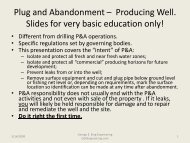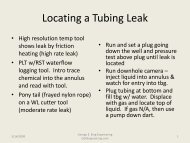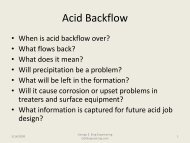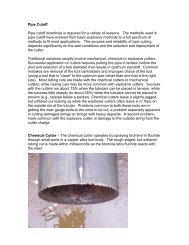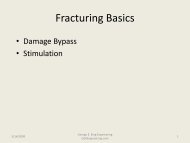Addressing the Environmental Risks from Shale Gas Development
Addressing the Environmental Risks from Shale Gas Development
Addressing the Environmental Risks from Shale Gas Development
Create successful ePaper yourself
Turn your PDF publications into a flip-book with our unique Google optimized e-Paper software.
<strong>Addressing</strong> <strong>the</strong> <strong>Environmental</strong> <strong>Risks</strong> <strong>from</strong><strong>Shale</strong> <strong>Gas</strong> <strong>Development</strong>Mark Zoback a , Saya Kitasei b , Bradford Copithorne cI. Executive SummaryThe rapid development of shale gas resources in <strong>the</strong> past few years has already dramaticallyaffected U.S. energy markets—lowering energy prices and carbon dioxide emissions—and couldoffer an affordable source of low-carbon energy to reduce dependence on coal and oil. 1 However,<strong>the</strong> development of shale gas has been linked to a range of local environmental problems,generating a public backlash that threatens to bring production to a halt in some regions. Whilehydraulic fracturing in particular has been <strong>the</strong> focus of much controversy, our analysis indicatesthat <strong>the</strong> most significant environmental risks associated with <strong>the</strong> development of shale gas aresimilar to those associated with conventional onshore gas, including gas migration andgroundwater contamination due to faulty well construction, blowouts, and above-ground leaksand spill of waste water and chemicals used during drilling and hydraulic fracturing.Many technologies and best practices that can minimize <strong>the</strong> risks associated with shale gasdevelopment are already being used by some companies, and more are being developed. Thenatural gas industry should work with government agencies, environmental organizations, andlocal communities to develop innovative technologies and practices that can reduce <strong>the</strong>environmental risks and impacts associated with shale gas development.Stronger, fully-enforced government regulations are needed in many states to provide sufficientprotection to <strong>the</strong> environment as shale gas development increases. In addition, continued studyand improved communication of <strong>the</strong> environmental risks associated with both individual wellsand large scale shale gas development are essential for society to make well-informed decisionsabout its energy future.This briefing paper, part of an on-going series on <strong>the</strong> role of natural gas in <strong>the</strong> future energyeconomy, provides an overview of how horizontal drilling and hydraulic fracturing are used toextract shale gas, examines <strong>the</strong> environmental risks, associated with shale gas development, andCover photo: A drilling rig near Shreveport, Louisiana, by danielfoster437.a Benjamin M. Page Professor of Geophysics, Stanford Universityb MAP Sustainable Energy Fellow, Worldwatch Institutec Finance Specialist, <strong>Environmental</strong> Defense Fund1






